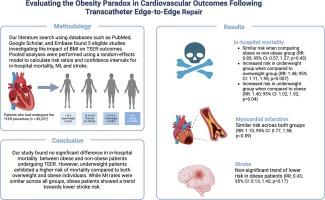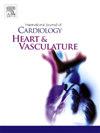Is there an obesity paradox in cardiovascular outcomes for patients undergoing Transcatheter Edge-to-Edge Repair? A pilot meta-analysis
IF 2.5
Q2 CARDIAC & CARDIOVASCULAR SYSTEMS
引用次数: 0
Abstract
Background
The impact of body mass index (BMI) on Transcatheter Edge-to-Edge Repair (TEER) outcomes remains uncertain, with studies showing conflicting results. Some suggest an ’obesity paradox’ exists, favoring better outcomes for obese patients and worse outcomes for underweight patients, while others report no significant impact of BMI.
Methodology
We systematically searched major databases for studies on baseline BMI and post-procedural outcomes in TEER patients. Patients were grouped by BMI: underweight (<18.5 kg/m2), normal (18.5–24.9 kg/m2), overweight (25–29.9 kg/m2), and obese (≥30 kg/m2). Data were pooled using a random-effects model, with risk ratios (RRs) and their 95 % confidence intervals (CIs) as effect measures. Statistical significance was set at p < 0.05.
Results
Our study, analyzing five observational studies with 7580 obese and 74,717 non-obese patients, found no significant difference in in-hospital mortality between the groups (RR: 0.85; p = 0.427). Subgroup analysis indicated a higher mortality risk for underweight patients compared to overweight (RR: 1.48; p = 0.006) and obese patients (RR: 1.40; p = 0.036), though the difference between underweight and normal-weight patients was not significant (RR: 1.18; p = 0.216). The risks of myocardial infarction (RR: 1.10; p = 0.592) and stroke (RR: 0.43; p = 0.166) were also similar between obese and non-obese patients.
Conclusions
In conclusion, our analysis found no significant difference in in-hospital mortality, myocardial infarction or stroke risk between obese and non-obese patients undergoing TEER. However, underweight patients may have a higher risk of in-hospital mortality compared to overweight and obese individuals, highlighting the potential impact of BMI on outcomes in TEER patients.

经导管边缘到边缘修补术患者的心血管预后是否存在肥胖悖论?试验性荟萃分析
背景体重指数(BMI)对经导管边缘到边缘修补术(TEER)结果的影响仍不确定,研究结果相互矛盾。一些研究表明存在 "肥胖悖论",肥胖患者的预后更好,而体重不足的患者预后更差,而另一些研究则报告称体重指数对预后无明显影响。方法我们系统地检索了主要数据库中有关经导管边缘到边缘修补术(TEER)患者基线体重指数和术后预后的研究。患者按体重指数分组:体重不足(18.5 kg/m2)、正常(18.5-24.9 kg/m2)、超重(25-29.9 kg/m2)和肥胖(≥30 kg/m2)。采用随机效应模型对数据进行汇总,以风险比(RR)及其 95 % 置信区间(CI)作为效果测量指标。我们的研究分析了五项观察性研究中的 7580 名肥胖患者和 74717 名非肥胖患者,发现两组患者的院内死亡率无显著差异(RR:0.85;P = 0.427)。亚组分析表明,体重不足患者的死亡风险高于超重患者(RR:1.48;P = 0.006)和肥胖患者(RR:1.40;P = 0.036),但体重不足患者与正常体重患者之间的差异并不显著(RR:1.18;P = 0.216)。肥胖和非肥胖患者的心肌梗死风险(RR:1.10;P = 0.592)和中风风险(RR:0.43;P = 0.166)也相似。然而,与超重和肥胖患者相比,体重不足的患者院内死亡风险可能更高,这凸显了体重指数对 TEER 患者预后的潜在影响。
本文章由计算机程序翻译,如有差异,请以英文原文为准。
求助全文
约1分钟内获得全文
求助全文
来源期刊

IJC Heart and Vasculature
Medicine-Cardiology and Cardiovascular Medicine
CiteScore
4.90
自引率
10.30%
发文量
216
审稿时长
56 days
期刊介绍:
IJC Heart & Vasculature is an online-only, open-access journal dedicated to publishing original articles and reviews (also Editorials and Letters to the Editor) which report on structural and functional cardiovascular pathology, with an emphasis on imaging and disease pathophysiology. Articles must be authentic, educational, clinically relevant, and original in their content and scientific approach. IJC Heart & Vasculature requires the highest standards of scientific integrity in order to promote reliable, reproducible and verifiable research findings. All authors are advised to consult the Principles of Ethical Publishing in the International Journal of Cardiology before submitting a manuscript. Submission of a manuscript to this journal gives the publisher the right to publish that paper if it is accepted. Manuscripts may be edited to improve clarity and expression.
 求助内容:
求助内容: 应助结果提醒方式:
应助结果提醒方式:


